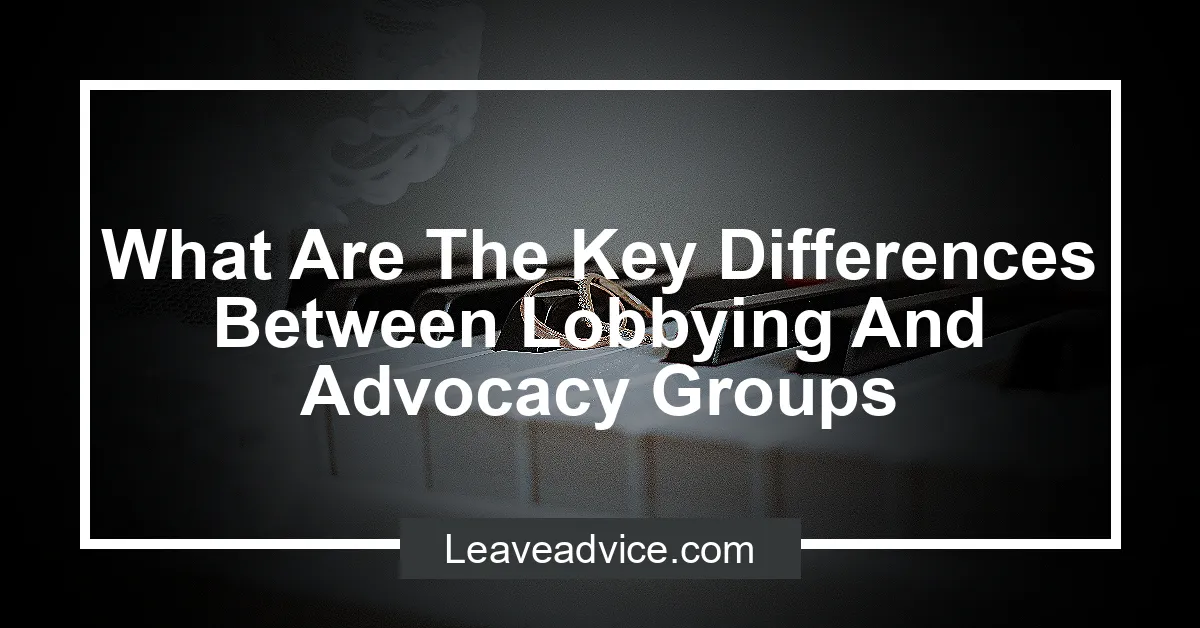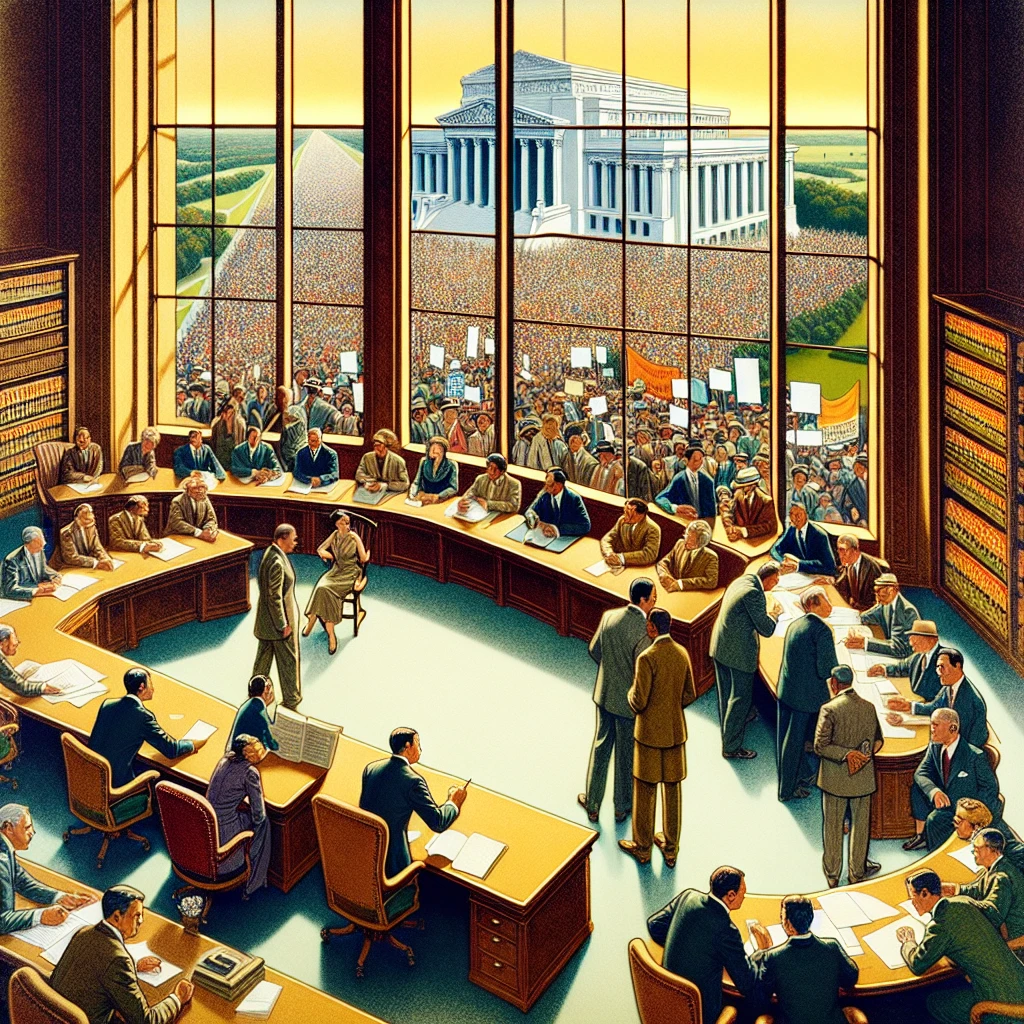What Are The Key Differences Between Lobbying And Advocacy Groups


Lobbying involves attempting to influence specific legislation at the local, state, or federal level, while advocacy is focused on educating about a specific issue. The main difference between lobbying and advocacy is that lobbying indicates an opinion about specific legislative change, such as particular changes to specific laws.
Advocacy makes up the majority of advocacy efforts by most nonprofits, while lobbying makes up a small portion. It is important to understand the key differences between lobbying and advocacy groups to ensure that the right approach is used when attempting to influence government decisions, policies, or legislation.
Understanding these differences can help organizations better achieve their goals and make a positive impact.
Check out this Youtube video: Gain greater understanding of the key differences between lobbying and advocacy groups and discover what you can do to make a difference in your community!
Purpose and Goals
The goals of lobbying groups
The primary goal of lobbying groups is to influence government decisions and policies towards a particular cause or interest. They aim to advocate for specific legislative changes that align with the interests of the group they represent.
This could include seeking tax incentives, environmental regulations, or healthcare reforms that benefit their constituents or members.
The goals of advocacy groups
Advocacy groups focus on promoting social change and raising awareness about important issues. Their goals revolve around influencing public opinion, educating communities, and mobilizing support for their cause.
This could involve initiatives to address social injustices, environmental conservation efforts, or public health awareness campaigns.
How the goals differ and overlap between the two types of organizations
The goals of lobbying groups are centered on directly influencing policy and legislation, often through direct engagement with lawmakers and government officials. Conversely, advocacy groups prioritize raising public awareness and community mobilization to bring about social or environmental change.
While both types of organizations seek to influence policy, lobbying groups often have a more direct involvement in shaping legislation, whereas advocacy groups focus on grassroots efforts and community engagement.
| Goals | Lobbying Groups | Advocacy Groups |
|---|---|---|
| Primary Focus | Influence government decisions and policies for specific interest | Promote social change and raise awareness about important issues |
| Target Audience | Lawmakers and government officials for direct policy influence | Public opinion, communities, and supporters for raising awareness |
| Approach | Engage in direct lobbying efforts, often involving professional lobbyists | Mobilize communities, conduct awareness campaigns, and social activism |
Legal Constraints
Regulations for lobbying groups
Lobbying groups are subject to stringent regulations, especially under the Political Reform Act. This act mandates the registration of individuals, businesses, and organizations involved in influencing state governmental decisions.
As per the law, these lobbying groups are required to submit periodic reports detailing their lobbying activities. Additionally, federal regulations, like the Lobbying Disclosure Act, necessitate quarterly reporting of all lobbying contacts to government officials.
Regulations for advocacy groups
On the other hand, advocacy groups primarily function to influence public policy and express support for causes. These organizations are subject to a different set of regulations aimed at ensuring transparency and accountability in their activities.
Unlike lobbying groups, advocacy groups are focused on informing and educating the public and policymakers about specific issues or causes without directly attempting to influence government decisions or policies.
Key differences in legal constraints between the two types of organizations
The primary distinction lies in the focus of their activities. Lobbying groups are heavily regulated in their efforts to directly influence government decisions, while advocacy groups face more relaxed regulations as they are primarily engaged in raising awareness and educating the public and policymakers.
This stark difference in legal constraints stems from the distinct nature of their objectives and methods, with lobbying groups actively targeting legislative changes and advocacy groups concentrating on public awareness and education.
| Lobbying Groups | Advocacy Groups | |
|---|---|---|
| Objective | Directly influence government decisions | Raise awareness and educate about specific causes |
| Reporting | Required to submit periodic reports detailing lobbying activities | Subject to less strict reporting requirements |
| Government Interaction | Actively aim to influence government officials | Focus on informing and educating without directly influencing government decisions |
| Legal Constraints | Stringent regulations under Political Reform Act and Lobbying Disclosure Act | Relaxed regulations with a focus on public awareness and education |
The legal constraints for lobbying and advocacy groups differ significantly, reflecting the distinct nature of their activities and objectives. While lobbying groups face stringent regulations and reporting requirements due to their direct involvement in influencing government decisions, advocacy groups operate under more relaxed constraints as they primarily focus on raising awareness and educating the public and policymakers.
Funding and Support
Sources of funding for lobbying groups
Lobbying groups receive funding from various entities such as corporations, trade associations, and influential organizations. These groups often leverage substantial financial resources to influence lawmakers and government policies in favor of their interests.
Companies, labor unions, and other influential entities contribute significant amounts, sometimes employing the services of lobbying firms or maintaining in-house lobbyists.
Sources of funding for advocacy groups
On the other hand, advocacy groups typically rely on diverse funding sources such as grants, donations from individuals and organizations, membership programs, and in-kind contributions. They often receive funding from foundations, private donors, and events aimed at supporting their cause.
These groups operate with a focus on promoting awareness and mobilizing support for specific social or political issues.
Differences in funding and support between the two types of organizations
The key difference in funding and support between lobbying and advocacy groups lies in the nature of their financing and the primary focus of their activities. While lobbying groups primarily secure financial backing from corporations and influential entities with the aim of directly influencing government policies, advocacy groups rely on a wider range of funding sources to support their efforts in raising awareness, empowering communities, and mobilizing public support for social or political causes.
| Aspect | Lobbying Groups | Advocacy Groups |
|---|---|---|
| Primary Funding Sources | Corporations, labor unions, influential organizations | Grants, donations, membership programs, in-kind contributions |
| Focus | Direct influence on government policies and legislative changes | Raising awareness, promoting social or political causes |
Both types of organizations play distinct roles in shaping public policy and societal trends, each leveraging unique approaches to secure the necessary funding and support to further their objectives.
Influence on Policy
The influence of lobbying groups on policy-making
Lobbying groups heavily influence policy-making through direct interactions with legislators, advocacy for specific legislative changes, and financial support for political campaigns. These groups often utilize professional lobbyists to represent their interests and sway decision-makers in their favor.
For instance, the National Rifle Association (NRA) has a significant impact on gun legislation through its lobbying efforts and political contributions, shaping policy outcomes in line with its agenda.
The influence of advocacy groups on policy-making
Advocacy groups, on the other hand, exert their influence on policy-making by mobilizing public support, organizing grassroots campaigns, and utilizing media platforms to raise awareness of particular social or political issues. A prime example is the American Civil Liberties Union (ACLU), which advocates for civil rights and liberties through public education, litigation, and community engagement, ultimately influencing policy decisions relating to civil rights laws and constitutional protections.
Contrasting approaches and impacts on policy decisions
The contrasting approaches between lobbying and advocacy groups lie in their methods of influence. While lobbying groups focus on direct engagement with policymakers and financial contributions, advocacy groups emphasize public mobilization and strategic communication to sway policy decisions.
These differing approaches, although distinct, both significantly impact policy-making by shaping legislative agendas and influencing the direction of public policy on various societal issues.
Strategies and Tactics
Common strategies and tactics used by lobbying groups
Lobbying groups often utilize direct persuasion techniques by meeting with government officials, offering campaign contributions, and organizing public relations campaigns. They also employ the use of lobbyists, engage in drafting legislation, and strategically leverage their networks to influence policymakers.
Common strategies and tactics used by advocacy groups
Advocacy groups typically focus on mobilizing public support through grassroots campaigns, organizing protests, and utilizing social media to spread awareness. They also engage in coalition building, engaging with the media, and conducting educational campaigns to influence public opinion and policy decisions.
How the strategies and tactics differ based on the objectives of each type of organization
The key difference in strategies and tactics lies in the objectives of each organization. Lobbying groups primarily focus on influencing specific policies to benefit their members, whereas advocacy groups are more concerned with addressing broader social and political issues to bring about systemic change.
This results in lobbying groups emphasizing direct interaction with policymakers, while advocacy groups concentrate on building public support and shaping public opinion.
Public Engagement
How lobbying groups engage with the public
Lobbying groups often utilize direct interaction and persuasion tactics to engage with the public. This may involve organizing events, conducting public relations campaigns, and leveraging media platforms to influence public opinion and mobilize support for their causes.
They aim to build strong relationships with policymakers and the public to advocate for their specific interests with a strategic focus on shaping legislation and regulations.
How advocacy groups engage with the public
Advocacy groups primarily engage with the public by raising awareness, educating, and empowering individuals to support their cause. They harness public sentiment by organizing rallies, creating educational campaigns, and mobilizing grassroots efforts.
Advocacy groups emphasize community involvement and public participation, aiming to empower individuals to become advocates for a particular cause, bringing about social change through public support and action.
Key differences in public engagement between the two types of organizations
| Aspect | Lobbying Groups | Advocacy Groups |
|---|---|---|
| Primary Focus | Legislation and regulation-based outcomes. | Raising awareness, educating, and empowering individuals. |
| Public Engagement Approach | Direct interaction, persuasion, and media influence. | Grassroots mobilization, rallies, and educational campaigns. |
| Relationship with the Public | Emphasis on building strong relationships with policymakers and influencing policy. | Focus on empowering individuals to become advocates for a particular cause. |
| End Goal | Shaping specific laws and regulations. | Bringing social change through public support and action. |
While both lobbying and advocacy groups engage with the public to further their causes, the methods and ultimate goals are distinct. Lobbying groups focus on directly influencing policymakers and legislation, while advocacy groups center their efforts on mobilizing public support for social change and empowerment.
Media Presence
The media presence of lobbying groups
Lobbying groups gain media presence through high-profile campaigns, targeted advertisements, and strategic press releases. They are known for leveraging influential connections with media outlets to amplify their messages and shape public opinion.
For instance, Big Tech lobbying groups have significantly increased their media engagement amid content moderation discussions, garnering extensive coverage in major news platforms like Politico and The New York Times.
The media presence of advocacy groups
Advocacy groups utilize media advocacy and social media strategies to promote their causes and engage with the public. They focus on raising awareness, educating the masses, and influencing policy decisions.
These groups rely on powerful social media strategies to effectively communicate their messages, engaging with various entities such as community members, organizers, and ally groups. They often deploy grassroots lobbying and work to secure coverage across mainstream media platforms to boost their exposure.
Contrasting approaches to media engagement and communication
Lobbying groups primarily engage with the media to influence legislation and gain political influence. Their media presence is often characterized by direct lobbying, targeted campaigns, and legal action.
On the other hand, advocacy groups focus on raising awareness and inform the public about specific issues or causes. Their media engagement revolves around public awareness campaigns, providing information, and social media influence to support their advocacy efforts.
Target Audiences
Target audiences of lobbying groups
Lobbying groups primarily target decision-makers and influencers who have the power to affect or make changes in policies, laws, regulations, and government decisions. These decision-makers can include government officials, legislators, and key committee members who have the authority to shape and enact policies.
Target audiences of advocacy groups
Advocacy groups focus on engaging decision-makers and influencers as their primary audience too. However, in addition to decision-makers, advocacy groups also target a wider audience including individuals, communities, and organizations that can support or contribute to the advocacy efforts.
This broader audience allows advocacy groups to build a grassroots movement to influence and impact change.
How the target audiences differ and impact the messaging and activities of each type of organization
The difference in target audiences impacts the messaging and activities of lobbying and advocacy groups significantly. Lobbying groups focus more on specific legislative and policy changes, often conveying their message with a direct and authoritative tone to appeal to decision-makers.
On the other hand, advocacy groups utilize a more inclusive approach, engaging a diverse audience and often employing grassroots mobilization and education to create broader public awareness and support for their cause. This distinction in target audiences leads to different messaging strategies and activities for each type of organization.
Ethical Considerations
Ethical considerations for lobbying groups
Lobbying groups must adhere to strict ethical guidelines, ensuring that their activities are transparent and that they disclose their interests and funding sources. It is imperative for lobbyists to conduct their activities in a fair and professional manner, avoiding any actions that would cause public officials to violate laws or regulations.
Upholding the broader public interest over narrow agendas is a key ethical principle for lobbying groups.
Ethical considerations for advocacy groups
Ethical considerations for advocacy groups revolve around assuring that clients are fully informed about the advocacy activities undertaken and the information gathered during the advocacy process. Advocates must prioritize responsible, accountable, transparent, and democratic political processes that benefit society at large.
They must also ensure that their actions are driven by the goal of enhancing the greater good.
Key differences in ethical considerations and practices between the two types of organizations
The key difference in ethical considerations between lobbying and advocacy groups lies in their primary objectives. Lobbying groups prioritize fair and professional conduct while safeguarding public officials from violating any laws.
Conversely, advocacy groups focus on promoting responsible, transparent political processes that benefit society. While both groups are ethical in their operations, their core ethical principles and organizational goals differentiate them significantly.
| Ethical Considerations | Lobbying Groups | Advocacy Groups |
|---|---|---|
| Transparency and Fairness | Must be transparent and fair while disclosing activities, interests, and funding sources. | Assure clients are fully informed about advocacy activities undertaken. |
| Public Interest Priority | Prioritize the public interest over narrow agendas. | Support responsible, accountable, and transparent political processes benefiting society. |
| Ethical Principles | Vigorous public debate necessary for informed decision making. | Driven by the goal of enhancing the greater good. |
Both lobbying and advocacy groups operate under stringent ethical considerations, focusing on transparency, fairness, and the broader public interest. However, their primary objectives and ethical principles are distinct, shaping their practices and organizational goals.
Success Metrics
How success is measured for lobbying groups
Success for lobbying groups is often measured by the impact on public policy, including the ability to influence legislation and regulatory decisions in favor of their cause. This impact is quantified by the number of policy changes achieved, level of engagement and support from key decision-makers, and the degree of public awareness generated by their lobbying activities.
How success is measured for advocacy groups
Advocacy groups measure success based on the effectiveness of their efforts in bringing about meaningful change. This can include the number of lives positively impacted, the passage of impactful legislation, and the prevention of harmful laws.
Additionally, success is gauged by the level of communication and collaboration established with lawmakers and the continuous improvement of public policies.
Contrasting metrics and indicators of success for each type of organization
| Success Metrics | Lobbying Groups | Advocacy Groups |
|---|---|---|
| Impact on Policy | Influence in legislative changes | Positive impact on public policy |
| Engagement | Level of support from decision-makers | Collaboration with lawmakers |
| Public Awareness | Generating public awareness | Continuous improvement of policies |
| Life Impact | Legislative changes | Positive impact on people’s lives |
Historical Perspectives
Historical evolution of lobbying groups
The evolution of lobbying groups dates back to the early days of the United States when powerful interest groups aimed to influence governmental decisions. Notably, the lobbying system saw its roots in the efforts to secure railroad subsidies and tariffs on wool.
The Constitution’s framers intended to design a governmental system where influential interest groups wouldn’t overpower the general will
Historical evolution of advocacy groups
Advocacy groups have a rich historical evolution, with their early growth being connected to broad economic and political changes. Throughout history, numerous significant advocacy groups have emerged, each contributing to social and political transformations.
The early evidence of advocacy groups can be traced back to common courtesy, where people lived in large groups and assisted one another as a norm. Advocacy groups’ history continues to evolve as they adapt to the changing social, economic, and political landscapes.
Contrasting historical contexts and influences on the development of each type of organization
The historical context and influences shaping the development of lobbying and advocacy groups significantly differ. While lobbying groups originated from the intent to influence governmental decisions and policy-making, advocacy groups stemmed from early societal norms of mutual assistance.
This contrast in historical context has led to distinct approaches and priorities for the two types of organizations. Lobbying groups focus on influencing specific policy outcomes, while advocacy groups place importance on broader social and political change.
| Comparison | Lobbying Groups | Advocacy Groups |
|---|---|---|
| Origin | Rooted in influencing government decisions | Emerged from societal norms |
| Focus | Target specific policy outcomes | Strive for broader social change |
| Key Influence | Special interest groups | Assimilation to societal norms |
Understanding the historical evolution and influences on lobbying and advocacy groups is crucial in comprehending their distinct characteristics and approaches in contemporary society.
Impact on Society
The societal impact of lobbying groups
Lobbying groups can have a significant impact on society by influencing policies and regulations that affect various aspects of people’s lives, such as healthcare, climate change, and consumer rights. However, this influence often raises concerns about undue influence, unfair competition, and the potential capture of policies to the detriment of the public interest.
The societal impact of advocacy groups
Advocacy groups play a crucial role in society by championing social justice causes, representing the voice of marginalized communities, and striving to bring about positive change through grassroots efforts and community mobilization. Their impact extends to issues related to civil liberties, combating discrimination, and promoting human rights.
Contrasting impacts on society based on the activities and objectives of each type of organization
The contrasting impacts of lobbying and advocacy groups on society stem from their distinct activities and objectives. While lobbying groups may wield influence through financial power and direct engagement with policymakers, advocacy groups primarily focus on raising awareness, mobilizing public support, and empowering communities to drive social and policy change in a more inclusive and equitable manner.
Contemporary Examples
Recent examples of successful lobbying efforts
| Date | Organization/Industry | Cause | Outcome |
|---|---|---|---|
| September 8, 2023 | Industry trade groups | Renewal of hazardous chemical program | Senate renewal of program to prevent hazardous chemical access by terrorists |
| 2022 | Tech Giants | Lobbying federal government | Tech giants spent nearly $69 million on federal lobbying, influencing technology policies |
| 2023 | OpenAI | Hiring European lobbyist | OpenAI’s strategic move to hire a European lobbyist for fostering AI-friendly regulations |
| 2016 | Various Organizations | Regulatory influence | Victories including environmental, retail, and manufacturing lobbying efforts |
Recent examples of successful advocacy campaigns
| Campaign | Objective | Result |
|---|---|---|
| Grassroots advocacy campaigns | Policy opinion sharing | Successful initiatives to influence policies through public engagement |
| Digital advocacy campaigns | Awareness building | Digital campaigns raising awareness about social and political issues |
| Advocacy campaigns in 2020 | Addressing public concerns | Advocacy efforts addressing pandemic, economic, and election-related issues |
| Grassroots advocacy campaigns | Policy influence | Success stories from various grassroots advocacy campaigns |
| Policy Advocacy and Nursing Organizations: A Scoping | Impact on policy advocacy outcomes | Nursing organizations’ impact on advocacy process and outcomes |
Illustrative cases to demonstrate the differences in impact and outcomes between the two types of organizations
The lobbying efforts reflect a focused approach to influence specific legislation or policies, often involving substantial resources and corporate agenda, while advocacy campaigns exhibit a broader public engagement strategy to raise awareness, address public concerns, and influence policies through grassroots support. The outcomes of advocacy campaigns are often geared towards addressing social and political issues, while lobbying efforts primarily aim to shape regulatory decisions and industry-specific regulations.
The lobbying victories, such as those by tech giants and industry trade groups, demonstrate a targeted influence on federal policy and regulations to safeguard corporate interests, whereas the successful grassroots advocacy campaigns illustrate the power of public engagement in influencing policy opinions and addressing societal concerns. These cases highlight the distinct impact and outcomes resulting from lobbying activities driven by corporate resources and strategic influence, compared to advocacy campaigns leveraging community support and public awareness efforts.
The recent examples of lobbying and advocacy efforts showcase the contrasting strategies and outcomes of these two types of organizations. While lobbying emphasizes targeted influence on legislation for specific industry agendas, advocacy campaigns focus on public engagement to address broader societal issues and influence policies through grassroots support.
Start your response with tag using markdown: ##
Challenges and Controversies
Challenges faced by lobbying groups
- Political and economic uncertainty poses a major challenge for lobbying groups, especially in 2023.
- Transparency and the perception of corrupt practices can create hurdles for lobbying groups.
- Common challenges include competition for resources, access, and profile along with maintaining effectiveness, innovation, and staff turnover.
Challenges faced by advocacy groups
- Advocacy groups often face challenges related to compatibility of frameworks, value bases, and approaches used by different organizations.
- They also encounter difficulties in living up to values and expectations, lack of innovation, creativity, and high turnover.
Key controversies and criticisms associated with each type of organization
- Lobbying organizations can face controversies related to undue influence, unfair competition, and policy capture, affecting effective policymaking.
- Advocacy groups may encounter criticisms linked to the effects of economic recession, challenging funding environments, and limited prospects for positive change.
| Lobbying Groups | Advocacy Groups |
|---|---|
| Political and economic | Compatibility of |
| uncertainty | frameworks and values |
| Transparency and | Meeting values and |
| corrupt practices | expectations |
Collaboration Opportunities
Opportunities for collaboration between lobbying and advocacy groups
Lobbying and advocacy groups have ample opportunities for collaboration, especially when striving for common goals such as policy change or social justice. By joining forces, these groups can pool resources, share expertise, and amplify their impact.
For instance, both groups can work together on issue identification, research, and public outreach, leveraging each other’s strengths to create a more impactful campaign.
Potential benefits of collaboration and cross-sector partnerships
Collaboration between lobbying and advocacy groups can bring multiple benefits, including increased credibility, broader support base, and enhanced influence. Additionally, cross-sector partnerships can lead to improved efficiency and increased scale, allowing the groups to reach their objectives with reduced individual investment.
By uniting efforts, these groups can effectively navigate the complexities of legislative processes and better advocate for their causes.
| Benefits of Collaboration | Explanation |
|---|---|
| Enhanced credibility | Combining efforts lends greater legitimacy to the cause. |
| Broader support base | Collaboration allows access to a wider audience. |
| Improved efficiency | Sharing resources reduces individual investment. |
| Increased scale | Partnerships can amplify the impact and reach of both groups. |
The collaboration between lobbying and advocacy groups presents a powerful opportunity to advance shared objectives while maximizing impact and influence. Leveraging each group’s expertise and resources through cross-sector partnerships can lead to more effective advocacy and lobbying efforts.
The collaboration between lobbying and advocacy groups presents a powerful opportunity to advance shared objectives while maximizing impact and influence. Leveraging each group’s expertise and resources through cross-sector partnerships can lead to more effective advocacy and lobbying efforts.
Recommended Amazon Products for Understanding the Differences Between Lobbying and Advocacy Groups
Here’s a curated list of products that can help you gain insights into the key differences between lobbying and advocacy groups. These recommendations are based on the relevance of the products to the topic, positive reviews, and availability on Amazon.
The Visual Display of Quantitative Information by Edward R. Tufte


This book provides in-depth analysis and examples of how data visualization impacts decision-making and influence on policy, contributing to a better understanding of lobbying and advocacy impacts.
Noise Cancelling Headphones by Sony


These headphones are great for eliminating distractions, allowing you to focus on detailed explanations and examples of lobbying and advocacy groups without any interruptions.
Whiteboard and Dry Erase Markers Set


A whiteboard can be helpful for visually mapping out the differences between lobbying and advocacy groups, while the markers allow for easy notation and organization of key points.
Agenda Planner by Clever Fox


Keeping track of the key concepts and important details about lobbying and advocacy groups in an organized planner can help you understand and compare the two subjects more effectively.
Document Camera for Online Teaching by IPEVO


This document camera is perfect for visual demonstrations and sharing detailed illustrations when learning about the influence of lobbying and advocacy groups.
Top Recommended Product for Gaining Insights and Understanding the Differences Between Lobbying and Advocacy Groups
If you’re looking for the best solution for understanding the key differences between lobbying and advocacy groups, we highly recommend The Visual Display of Quantitative Information by Edward R. Tufte. This book provides comprehensive insights and examples that contribute to a better understanding of the topic.
Ready to enhance your understanding of lobbying and advocacy groups? Check out The Visual Display of Quantitative Information today for the best results!
| Products | Pros | Cons |
|---|---|---|
| Visual Data Information Book | Comprehensive insights and examples | Requires time to read thoroughly |
| Noise Cancelling Headphones | Eliminates distractions for focused studying | May require additional purchase |
| Whiteboard and Markers Set | Visual mapping and easy notation capability | Requires additional space for installation |
| Agenda Planner | Organized system for tracking key concepts | Can be subjective based on individual use |
| Document Camera | Visual aid for detailed illustrations | Additional setup may be required |
Conclusion
Lobbying groups primarily focus on directly influencing government officials or policymakers to create or change specific laws or policies. They often utilize professional lobbyists to advocate for their interests and may also provide campaign contributions to gain access and influence.
On the other hand, advocacy groups focus on promoting specific causes or addressing social issues through education, awareness campaigns, and grassroots organizing. They may engage in lobbying as part of their overall strategy but their main emphasis is on raising awareness and mobilizing public support for their cause.
Furthermore, lobbying groups are typically driven by the interests of specific industries, corporations, or professional associations, with the goal of shaping legislation and regulations to benefit their stakeholders. They often have significant financial resources, access to decision-makers, and specialized knowledge on policy issues.
In contrast, advocacy groups are often nonprofit organizations that represent the interests of marginalized communities, social justice causes, or environmental concerns. They work to influence public opinion, mobilize supporters, and hold decision-makers accountable for addressing the needs of the communities they serve.
In addition, one key difference between lobbying and advocacy groups is the level of direct involvement in the political process. Lobbying groups are deeply involved in the legislative process, engaging in activities such as drafting legislation, providing testimony at hearings, and directly meeting with lawmakers.
Advocacy groups, while they may engage in some similar activities, typically focus more on mobilizing grassroots support, conducting public education campaigns, and promoting social change through public dialogue and awareness. Both play critical roles in shaping public policy, but their approaches and methods are distinct.












